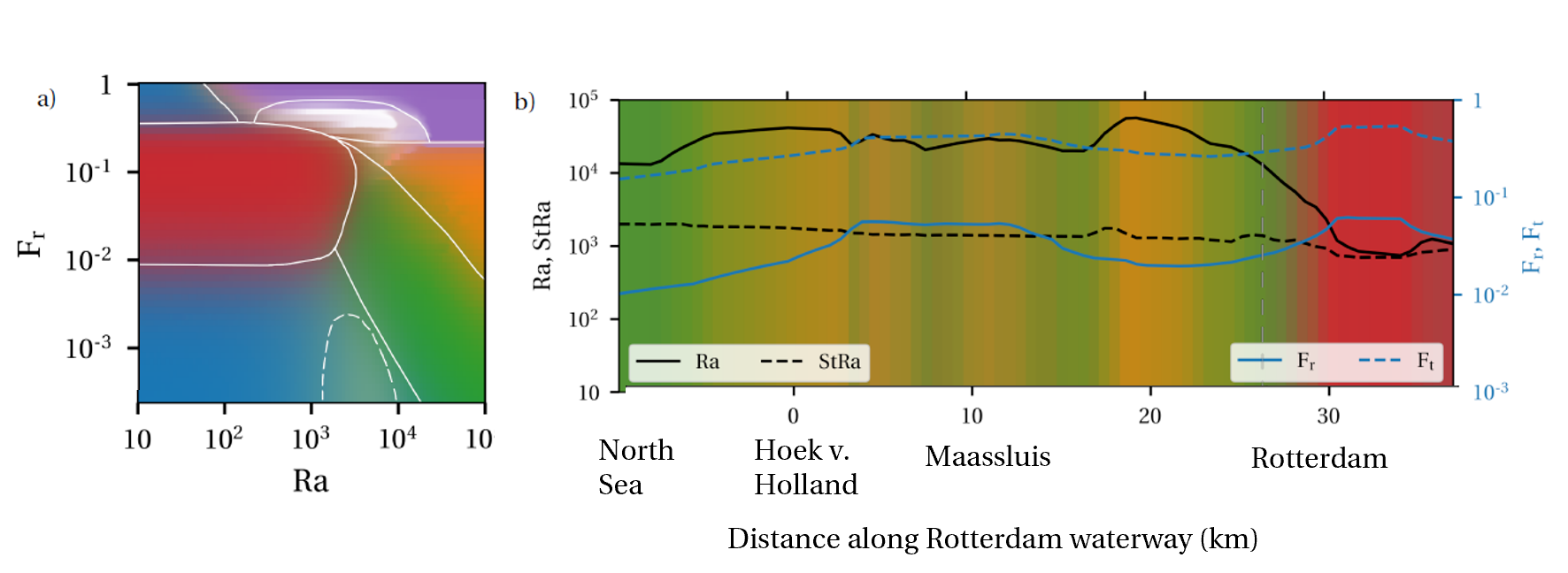Y.M. Dijkstra1*, H.M. Schuttelaars1, W.M. Kranenburg2,3
1 Delft Institute of Applied Mathematcis, TU Delft
2 Deltares
3 Faculty of Civil Engineering and Geosciences, TU Delft
*corresponding author:
Introduction
The distribution of salt in an estuary continuously adapts to the various processes that import and export salt. Tidally-averaged, these transport processes are categorised as subtidal processes or tidal covariance (hereafter 'tidal processes'). Analysis of salt transport in various estuaries has shown that either subtidal or tidal processes can be dominant. The various subtidal and tidal transport processes each have a different sensitivity to changing forcing parameters (e.g. tides, river discharge, sea level) and geometry (depth or width). Hence, to understand how the salt intrusion responds to climate change, it is important to understand which mechanisms dominate the salt transport.
There is currently no comprehensive theory that describes the relative importance of subtidal and tidal processes as a function of the estuarine parameters, such as depth, width, river run-off or tides for general estuaries. Therefore, the aim of this contribution is to construct a classification that shows the relative importance of subtidal and tidal transport processes across a large range of estuarine parameters, where we focus on width-averaged processes.
Methods
The classification is derived from a systematic analysis of a process-based model. The model is purpose-built to allow for studying a very large number of model configurations (>40.000 experiments) covering a wide range of estuarine conditions. For each model experiment, the salt balance is analysed. For validation, the classification is applied to the Rotterdam Waterway to conclude which salt transport processes dominate.
Results
We find that the salt transport is dominated by one of seven salt transport balances, or regimes (Fig 1a). The dominant regimes are described as a function of four dimensionless parameters. During the presentation, we will explain two specific regimes: one dominated by subtidal density-driven flow (green in Fig 1) and one dominated by tidal flow (red in Fig 1).
Application to the Rotterdam Waterway shows this estuary features multiple regimes (Fig 1b), with import dominated by subtidal regimes in the seaward part and a tidal regime in the landward part. These results are confirmed by a direct decomposition of the salt flux in a 3D SIMONA model.

Figure 1: a) A slice of the classification scheme. Each colour indicates a regime that dominates the salt balance for given parameters. Here plotted are two of the four estuarine parameters: Fr (measuring fresh water discharge) and Ra (measuring mixing). For example, the green/orange regimes are dominated by subtidal density-driven flow, while the red regime is dominated by tidal flow. b) parameter values for the Rotterdam Waterway during low discharge, with colours matching those in the classification. A transition from subtidal regimes (green/orange) to a tidal regime (red) is observed.
I. Surname1*, F.N. Another-Surname2 , Y. Next-Surname2
1 University Name, Country; 2 Organization Name, Country
* Corresponding author: mail.name@organization.org


